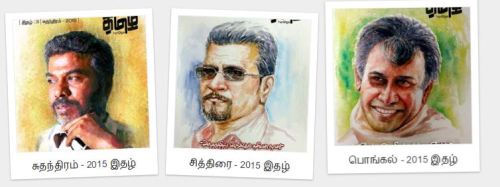தமிழ் மின்னிதழ் பிடிஎஃப் வடிவில் வருகிறது. இது போன்ற முயற்சிகளுக்கு 2003ல் தமிழோவியம் தீபாவளி, பொங்கல், ஆண்டு விழா சிறப்பிதழ் மலர்களையும் ஸ்ரீதர் நாராயணன் தயாரித்த பண்புடன் மடலாடற் குழும சிறப்பிதழ்களையும் முன்னோடியாகப் பார்க்கிறேன்.

எழுத்தாளர்களுக்கு சிறப்பிதழ் கொண்டு வருவது நல்ல விஷயம். ஆனால், கருப்பொருள் சார்ந்து, ஒரே ஒரு விஷயத்தை எடுத்துக் கொண்டு இரு பக்க எண்ணங்களையும் மாற்றுக் கருத்துக்களையும் ஆழமாக அலசுவது அதனினும் சாலச் சிறந்தது.
அந்த மாதிரி ஏன் — தமிழ் மேகசின், பதாகை போன்ற தமிழில் வரும் சிற்றிதழ்கள் செய்வதில்லை?
இதழை வெளியிட்ட ‘காலச்சுவடு’ கண்ணன் இவ்வாறு சொல்லி இருக்கிறார்:
பெருமாள் முருகன் சிறப்பிதழாக, அவர் படைப்புகளை விவாதித்து இந்த இதழ் வெளிவருவது பெரு மகிழ்ச்சி.
நிஜமாகவே பெருமாள் முருகனை அலசி ஆராய்ந்து இருக்கிறார்களா அல்லது
- புத்தக அறிமுகம்,
- அவர் எழுதிய நாவலை விதந்தோதுதல்,
- ஏற்கனவே இணையத்தில் கிடைப்பதை வைத்து வாந்தியெடுத்தல்,
- கதைச் சுருக்கத்தை மட்டும் சொல்லி விமர்சனம் என்று பஜனை செய்யுதல்,
போன்றவை மட்டுமே செய்துவிட்டு
- சம காலத்தின் மற்ற ஒப்புமையான படைப்புகளுடன் சீர்தூக்கி அலசுதல்,
- எழுத்தாளனின் வளர்ச்சி: துவக்க காலப் படைப்புகளுக்கும் பிற்கால ஆக்கங்களுக்கும் இடையே உள்ள ஒப்பீடு,
- எழுத்தாளரின் சிறுகதைகளுக்கும் நெடுங்கதைகளுக்கும் உள்ள வித்தியாசங்கள் / ஒற்றுமைகள்,
- எழுதியவரின் நடை, கதைக்கரு, களன், உத்தி போன்றவை சார்ந்த குறுக்குவெட்டுத் தோற்றம்,
போன்றவையும் அலசப்பட்டிருக்கிறதா என்று இனிதான் ஆராய வேண்டும்.
இப்போதைக்கு புறத்தோற்றம் பற்றிய குறிப்புகள். புறத்தோற்றம் ஏன் முக்கியம் ஆகிறது?
மத நம்பிக்கையாளருக்கு அந்த மதத்தின் சின்னங்கள் முக்கியம். இஸ்லாமியருக்கு தொப்பியும் தாடியும். வைணவருக்கு திருமண். பௌத்தருக்கு அவர்களின் சிவப்பும் ஆரஞ்சும் கலந்த வஸ்திரம். இறைவரை பின்பற்றுவர்களுக்கும் இலக்கியத்திற்கும் சம்பந்தம் இல்லை என்று விட்டுவிட்டாலும், கல்யாணம் / காட்சி என்றால் ஒவ்வொருவருக்கும் ஒரு உடை பாவனை இருக்கிறது. மோதிரம் மாற்றிக் கொள்வது, வேட்டி கட்டுவது என்று ஒவ்வொரு இடத்திலும் ஒவ்வொரு அலங்காரம் தேவைப்படுகிறது.
இவ்வளவு ஏன்? கோட்டு சூட்டு போட்டுக் கொண்டு கோடைகாலத்தில் கடற்கரைக்கு சென்றால், எப்படி எடுத்துக் கொள்ளப்படும்? ஒன்று அங்கிருக்கும் பிகினி அழகர்களை தரிசிக்க வந்த பரதேசி என நினைத்து தர்ம அடி வழங்கப்படும். இரண்டாவது, அத்தனை வெயில் அடிக்கும் அந்தச் சூழலுக்கு, அவ்வளவு தடிமனான மேலாடை தேவை கிடையாது.
“தமிழ் பத்திரிகை”யின் வடிவமைப்பும் சோபையாக இருக்கிறது. அட்டைப்படம் எடுப்பாக இருப்பது போல், பிடிஎஃப் கோப்பின் உள்ளே, சுவாரசியமான, கவர்ச்சியான, பக்க அமைப்பு கிடைக்கவில்லை.

– தலைப்புகளுக்கு சிறிய எழுத்துரு, அதே தடிமனில் எழுத்தாளரின் எழுத்துரு என்று ஏனோ தானோ என்று அவசரகதியில் போட்டிருக்கிறார்கள்.
– ஒவ்வொரு கட்டுரையும் தனித் தனிப் பக்கங்களில் துவங்காமல், முந்தைய கட்டுரை முடிந்த சடுதியில், அடுத்த கட்டுரை, முக்கால் பக்கத்தின் இறுதியில் உட்கார்ந்து இருக்கிறது.
– கவிதா முரளிதரனுக்கு பெருமாள் முருகனை விட மிகப் பெரிய புகைப்படம் போட்டு இருக்கிறார்கள். சுரேஷ்கண்ணன் போன்ற ஆண்களுக்கு தபால்தலை அளவு ஒளிப்படம் கூட கிடையாது.
– திடீரென்று @iAgarshana எல்லாம் வருகிறது. அது ஃபேஸ்புக் முகவரியா, எல்லோருக்கும் இது போல் சுட்டல் உண்டா, எந்த வலையகத்தின் உரல் இது என்று எந்தக் குறிப்பும் கிடைக்கவில்லை. இந்த மாதிரி இடங்களில் இந்தப் படைப்பு குறித்த சிறு முன்னோட்டத்தையும் அது எந்த மாதிரி ஆக்கம் (புனைவு, கட்டுரை, டிவிட் தொகுப்பு) என்பது குறித்த அறிமுகமும் அவசியம். அவை போன்ற எதுவும் இல்லாமல், அந்தப் படைப்பும் மேலெழுந்தவாரியாக சேமிக்கப்பட்டிருக்கிறது. கண்டதையும் கண்ட மேனிக்குத் தொகுக்க, இது நோட்டு புத்தகம் அல்ல. காலாண்டுக்கு ஒரு முறை வரும் அச்சிதழ். அதற்குரிய சிரத்தையும் பொறுப்புமில்லாமல் வெளியாவது உள்ளடக்கத்தையே ஏளனம் செய்கிறது.

– மேலே இருக்கும் பக்கத்தின் இறுதியில் ஒருவரின் ஒளிப்படம் இருக்கிறது. அவர் யார்? அவரின் கதையை எப்படி இந்த இதழுக்குத் தேர்ந்தெடுத்தார்கள்? எழுதியவரே அந்தக் கதையை ‘தமிழ்’ மின்னிதழுக்காக மொழிபெயர்த்தாரா? ஏன் இந்தப் புனைவை மொழிபெயர்த்தார்? இப்படி எதுவும் இல்லாமல், ‘எடுத்தோமா… சிரைத்தோமா!’ என்பதற்கும் வலைப்பதிவில் கண்டதையும் கிறுக்குவதற்கும் என்ன வித்தியாசம்?

– அதே போல் இந்தப் படத்தையும் எடுத்துக் கொள்ளலாம். நாகராஜ் இதை எவ்வாறு உருவாக்கினார்? அவரே வரைந்தததா? எந்த வகை உத்திகளை வைத்து எத்தனை கால அவகாசத்தில் இந்தப் படத்தை உருவாக்கினார்? ஃபோட்டோஷாப் போன்ற கருவிகளை உபயோகித்தாரா? தாளில் வரைந்தாரா? நாகராஜின் மற்ற படைப்புகள் எங்கே கிடைக்கும்?
– சுதந்திரம் என்று பக்கத்திற்கு பக்கம் அடிக்குறிப்பு இட்டிருக்கிறார்களே… எது சுதந்திரம், எப்பொழுது சுதந்திரம், யாருக்கு சுதந்திரம், எதற்கு சுதந்திரம் என்று ஒரு குவிமையம் கிடைக்காமல், தமிழ் சினிமாவிற்கு தமிழில் தலைப்பு வைப்பது போல், இந்த இதழுக்கும் ஏதோவொரு தலைப்பு வைத்துக் கொண்டிருக்கிறார்கள்.
இரண்டாவது இதழை வெளியிட்டிருக்கும் மனுஷ்யபுத்திரன் இவ்வாறு சொல்கிறார்:
சமீபத்தில் ஒரு நேர்காணலில் தமிழில் சிற்றிதழ் இயக்கதிற்கு எதிர்காலம் இருக்கிறதா? என்று என்னிடம் கேட்டார்கள். நான் அதற்கு ‘நிச்சயம் இருக்கிறது. ஆனால் அச்சு வடிவிலான சிற்றிதககள் பெருமளவு மறைந்து அவை இணைய இதழ்களாக நீடித்திருக்கும்’ என்று சொன்னேன். இந்த இதழை பார்க்கும்போது அந்த எண்ணம் வலுப்படுகிறது. பத்திரிகை நடத்துவதன் லெளகீக கஷ்டங்கள் இல்லாமல் படைப்பு சார்ந்து மட்டும் ஒரு இதழாளன் முக்கிய கவனம் செலுத்த இந்த தளம் பெரிதும் பயன்படும்.
ஞாநி இவ்வாறு எழுதுகிறார்:
மின்னிதழ்களையும் படைப்பாளிக்கும் வாசகருக்கும் இடையே இருக்கக்கூடிய அச்சிடுபவர், விநியோகஸ்தர், கடைக்காரர் என்ற சக்திகளைத் தவிர்த்து நேரடியாக உறவு கொள்ள உதவும் முக்கிய வடிவமாகவே நான் பார்க்கிறேன். இந்த முயற்சியில் எந்த வணிக சமரசமும் ஊடுருவாமல் இயங்கும் வசதி படைப்பாளிகளுக்குக் கிட்டுவது என்பது மிக முக்கியமான மாற்றமாகும். நவீன தொழில்நுட்பம் என்பது வணிக நுகர்வுக் கலாசாரத்துக்குத்தான் பயன்படும் என்ற புரிதலையும் இது மாற்றியமைக்கிறது. இதழ் நடத்துதல், படம் எடுத்தல் ஆக்கியவற்றையெல்லாம் மேலும் ஜனநாயகப்படுத்துகிறது. எனவே இதை நாம் எல்லாரும் வரவேற்கவேண்டும்.
– எல்லாமே தெரிந்த, புழக்கமான பெயர்கள், இணையப் பிரமுகர்கள். இந்த மாதிரி பிரபலங்களை மட்டும் வைத்து மின்னிதழ் எதற்காக நடத்த வேண்டும்? அறியாத எழுத்துக்களை, புகழ் பெறாத எழுத்தாளர்களை, தெரியாத ஆக்கங்களை முன்னிறுத்துவதற்கு சிற்றிதழ் வாயிலாக இருக்க வேண்டும். அச்சிதழ்கள் போல், நாலாயிரம் ஃபாலோயர்ஸும் நாற்பது வலைப்பக்க வாயிலும் கொண்டவர்களை வைத்து வாந்தி எடுக்கக் கூடாது.
சம காலத்தில் ஆங்கிலத்தில் வெளிவரும் சில பத்திரிகைகளை இங்கு ஒப்பிட்டு பார்க்கலாம். கீழே ஆறு பத்திரிகைகளின் சமீபத்திய இதழ்களின் முகப்பும் அமைப்பும் பார்க்கலாம்:

தமிழ் மின்னதழின் ஆசிரியர் சரவணகார்த்திகேயன் இவ்வாறு சொல்கிறார்:
அச்சிதழில் ஒவ்வொரு பக்கமாய்ப் புரட்டித்தான் குறிப்பிட்ட படைப்பை அடைவோம். ஒருவேளை உள்ளடக்கம் கொடுக்கப்பட்டிருந்தால் அதன் மூலம் பக்க எண்ணை அறிந்து கொண்டு குறிப்பிட்ட படைப்புக்குத் தாவலாம். இது வரை தமிழ் இதழிலும் சாத்தியம். உள்ளடக்கம் கண்டு, பக்க எண் அறிந்து, நீங்கள் பயன்படுத்தும் PDF reader-ல் பக்க எண் கொடுத்தால் அழைத்துச் சென்று விடும். ஹைப்பர்லிங்க் கிடையாது! (சேர்ப்பது சுலபமெனினும் தவிர்த்தேன்.)
சுருங்கச் சொன்னால் ஓர் அச்சு இதழை நீங்கள் எப்படிக் கையாள முடியுமோ அப்படியே இதையும் கையாள வேண்டும்.
இந்தக் கருத்து ஏற்றுக் கொள்ளக்கூடியது அல்ல. ஓலைச்சுவடியில் ஒற்றெழுத்து இல்லாமல் எழுதினோம், நாலு வரி மட்டுமே எழுதினோம் என்று இன்றும் தொங்கிக் கொண்டிருக்கவில்லை. நவீன சாதனங்களை, புதிய நுட்பங்களை, வசதியான வடிவங்களை கையாள்கிறோம். கியாஸ் அடுப்பு வந்தபிறகும் கரி அடுப்பில்தான் சமைப்பேன் என்று அடம்பிடிப்பது முட்டாள்தனமானது.
எழுதுபவர்களுக்கு காசும் தரமாட்டேன்; எழுதியவற்றை வெளியிடுவதிலும் புதுமை செய்ய மாட்டேன்; எழுதுபவர்களிலும் புதியவர்களை அடையாளம் காட்ட மாட்டேன்; எழுதப்படும் கருத்திலும் சிதறலாக, கிடைப்பதை வைத்து ஒப்பேற்றுவேன் – என்ற முன்முடிபை இதன் தயாரிப்பாளர்கள் கைவிட வேண்டும்.
அன்பர்களுக்கு நான் மீண்டும் நினைவூட்ட விரும்புவது ஒன்றைத் தான். தற்போதைக்கு தமிழ் தீவிர இலக்கிய இதழ் அல்ல; போலவே வெகுஜன இதழும் அல்ல. இடைப்பட்டது. ஆனால் இதன் எதிர்காலப் பயணம் தீவிர இலக்கிய இதழ் என்பதை நோக்கியதாகவே இருக்கும். அதுவரை கசியவிருக்கும் சுஜாதாத்தனங்களை தீவிரர்கள் பொறுத்தருளலாம்.
இந்த இதழில் எழுதியவர்களில் பார்த்தவுடன் பரிச்சயமான வலை / அச்சுப் பத்திரிகைப் பெயர்கள் சிலவற்றை இங்கு சொல்லிப் பார்க்கிறேன்
– கவிதா முரளிதரன்
– சுரேஷ் கண்ணன்
– கிருஷ்ண பிரபு
– லேகா
– கவின் மலர்
– நர்சிம்
– யுவகிருஷ்ணா
– அதிஷா
– என் சொக்கன்
– முரளிகண்ணன்
– எஸ்.கே.பி. கருணா
– ஜிரா
இதழ் பெரும்பாலும் என் உழைப்பில் மட்டுமே வெளியாகப் போகிறது என்பதால் லேஅவுட் எளிமையானதாகவே அமையும். படைப்பிற்குப் பொருத்தமான ஓவியம், புகைப்படம் சேர்த்திருக்கலாம் எனக் குறைப்பட வேண்டாம்.
‘செய்வன திருந்தச் செய்’ என்பது ஆத்திச்சூடி. வேலையை எடுத்துக் கொண்டால் அதில் நம்முடைய 100% மின்ன வேண்டும். சால்ஜாப்பு சொல்வதை விட்டுவிட்டு, பொருத்தமான நபர்களிடம் பொறுப்புகளை பகிர்ந்தளித்தல், ஆக்கங்களில் மேலும் செப்பனிடுதலை — அதே இதழில் வெளியாகும் சக படைப்பாளிகளிடம் கருத்து கேட்டு செதுக்குதல் என்று இந்த விஷயம் மேன்மையுற வேண்டும்.
ஜெயமோகன் இவ்வாறு எழுதுகிறார்:
இணையத்தில் உதிரி குறிப்புகளாக வெளியாகிக்கொண்டிருக்கும் எழுத்துக்களை ஒரே இடத்தில் பிரசுரிப்பது இதன் நோக்கம். பொதுவாக இணையதளம் என்பதே இணையஇதழாக இங்கே கொள்ளப்படுகிறது. ஆனால் இவ்விதழ் இணையம் மூலம் வாசிக்கக் கிடைக்கும் இதழ். தரவிறக்கம் செய்தோ நேராகவோ வாசிக்கலாம்.
இணையத்தில் கிடைக்கும் வலைப்பதிவு ஒருங்கிணைப்பாளர்களையும் திரட்டிகளையும் இணையப் பத்திரிகைகளையும் பார்க்கலாம்:
இவை எல்லாம் விகடன் மாதிரி ஒரே தரத்தில், கொள்கையோடு இயங்காவிட்டாலும், அட்டையில் ஏமி ஜாக்ஸனின் கவர்ச்சிப்படம் போட்டுவிட்டு, நடிகையின் பாகங்களை மறைக்குமாறு ‘மதுவருந்தி சீரழியும் தமிழன்’ என்று போலி பம்மாத்துகளில் ஈடுபடுவதில்லை.
கீழே விகடனின் ஃபேஸ்புக் பக்க உரையாடலும் சாம்பிள் அட்டைப்படமும்:

ஆனந்த விகடன் மாதிரி இதழ்களுக்கு அகம் போன்ற மின்னிதழ்கள் நல்ல மாற்று என்பதில் விகடன் குழுமத்திற்கே சந்தேகம் இருக்காது. ’தமிழ்’ இதழை விட, வடிவமைப்பில் ‘அகம்’ போன்ற மின்னிதழ்கள் மிளிர்கின்றன என்பதில் எனக்கு மாற்றுக்கருத்து கிடையாது
மீண்டும் பெருமாள் முருகன் + சுதந்திரம் + தமிழ் மின்னிதழ் விமர்சனத்திற்கே வருவோம்.
தமிழில் வரும் சிற்றிதழ்கள் என்று தமிழ் ஸ்டூடியோ பக்கத்தில் இவற்றைச் சொல்லி இருக்கிறார்கள்:
- அணங்கு
- அணி
- அதிர்வு
- அநிச்ச
- அம்ருதா
- ஆக்காட்டி | aakkaddi.com
- ஆயுத எழுத்து
- இனிய நந்தவனம்
- இனிய ஹைக்கூ
- உங்கள் நூலகம்
- உயிர்மை
- உழைப்பவர் ஆயுதம்
- உன்னதம்
- கணையாழி
- கதை சொல்லி
- கலை
- கல்வெட்டு பேசுகிறது
- கவிதாசரண்
- கனவு
- காலச்சுவடு
- காலம்
- கிழக்குவாசல்
- குழலோசை
- கூட்டாஞ்சோறு
- சமரசம்
- சோலைக்குயில்
- சௌந்தரசுகன்
- தச்சன்
- தமிழ் நேயம்
- தமிழ் பணி
- தலித்முரசு
- தாமரை
- தாய்மண்
- திரை
- தீராநதி
- தை
- நடவு
- நம் உரத்த சிந்தனை
- நவீன விருட்சம்
- நறுமுகை
- நிழல்
- படப்பெட்டி
- பன்முகம்
- புதிய பார்வை
- புதிய புத்தகம் பேசுது
- புதுகைத் தென்றல்
- புதுவிசை
- பெண்ணியம்
- மண்மொழி
- மலர்
- மீண்டும் கவிக்கொண்டல்
- முகம்
- மெய்யறிவு
- யாதும் ஊரேமது
- வடக்கு வாசல்
- வல்லினம்
- விழிப்புணர்வு
இவற்றில் பல – இன்று வெளியாகவில்லை. இவற்றில் சில பெரும் குழுமங்களான குமுதம் போன்றவற்றில் இருந்து அதற்கான நிதியாதாரங்களுடன் வெளியாகின்றன. இவற்றில் – மனுஷ்யபுத்திரன் வெளியிடும் உயிர்மை போல் சில பத்திரிகைகள் அரசியல் கட்சி சார்பானவை. அவற்றின் கொள்கைகளை, தலைவர்களை, சித்தாந்தங்களை – விமர்சன நோக்கு இல்லாமல் முன்னிறுத்தி வெளியிடப்படுபவை.
ஆனால், பலவும் தனி மனிதரின் விருப்பத்தால் உண்டாகுபவை. அவற்றில் காணக் கிடைக்காத நேர்த்தியும் வெரைட்டியும் இணைய இதழ்களில் கிடைக்க வேண்டும். அச்சுக்குரிய நிர்ப்பந்தந்தங்களும் பொருட்செலவும், வலைவெளியில் கிடையாது.

– விக்கிப்பிடியா போன்ற இந்தப் பக்கத்தின் அவசியம் என்ன? ஆங்கில எழுத்துக்களை எல்லாம் பெரிய அப்பர்கேஸ் எழுத்துக்களாகவே போடுதல் போன்றவை சிறிய பிழைகள். காலச்சுவடு ஆசிரியர் குழுவில் எப்போது இணைந்தார் போன்ற தகவல் விடுபடுதல்கள் இன்னும் ஆபத்தானவை. எளிதில் தவிர்க்கக்கூடியவை.
– மோசமான புற உருவத்தை வைத்து அகத்தை மதிப்பிட முடியாது. முழுக்க படித்துவிட்டு, உள்ளடக்கத்தின் செறிவை தனியாக எழுத முயல்கிறேன்.
நான் எழுத நினைப்பதை எல்லாம், ஜெயமோகன் எண்ணியும் எழுதியும் வைத்திருக்கிறார்:
பெரும்பாலான இணைய இதழ்களில் எதுவும் வெளியாகும் என்ற நிலை உள்ளது. அதை அதன் ஆசிரியர்களே வாசிப்பதில்லை. அதில் ஒரு தேர்வு இல்லை. விளைவாக ஏராளமான தரமற்ற பக்கங்கள் முன்வைக்கப்படும்போது வாசகன் காலப்போக்கில் சலித்து விலகிவிடுகிறான்
சமீபத்தில் வாசித்த ஆங்கில சிறு பத்திரிகைகள், குறுகிய வட்டத்திற்குள் வெளியாகும் சஞ்சிகைகள் குறித்த என்னுடைய பதிவு: நூலகம் – 2015 புத்தகங்கள்
















































Nanjil Nadan meet at New Jersey: Live Report & Commentary by sharpshooting critic Dyno
Thanks: @dynobuoy
http://twitter.com/dynobuoy/status/209440304162545664
பின்னூட்டமொன்றை இடுக
Posted in Tamil Blog
குறிச்சொல்லிடப்பட்டது Authors, Commentary, Comments, Critics, Discussions, Dyno, Dynobuoy, Feedback, Forums, Live, Meets, Naanjil Naadan, Nanjil Nadan, NJ, NN, NYC, Opinions, Readers, Report, Tamils, Thamils, Twitter, Writers